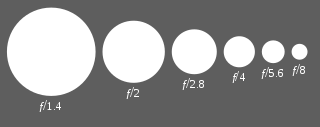
Depth of field is the distance between the nearest and the furthest objects that are in acceptably sharp focus in an image. The depth of field is determined by focal length, distance to subject, the acceptable circle of confusion size, and aperture. A particular depth of field may be chosen for technical or artistic purposes. Some post-processing methods, such as focus stacking allow extended depth of field that would be impossible with traditional techniques.

In optics, chromatic aberration is a failure of a lens to focus all colors to the same point. It is caused by dispersion: the refractive index of the lens elements varies with the wavelength of light. The refractive index of most transparent materials decreases with increasing wavelength. Since the focal length of a lens depends on the refractive index, this variation in refractive index affects focusing. Chromatic aberration manifests itself as "fringes" of color along boundaries that separate dark and bright parts of the image.
The focal length of an optical system is a measure of how strongly the system converges or diverges light. For an optical system in air, it is the distance over which initially collimated (parallel) rays are brought to a focus. A system with a shorter focal length has greater optical power than one with a long focal length; that is, it bends the rays more sharply, bringing them to a focus in a shorter distance.

The f-number of an optical system is the ratio of the system's focal length to the diameter of the entrance pupil. It is a dimensionless number that is a quantitative measure of lens speed, and an important concept in photography. It is also known as the focal ratio, f-ratio, or f-stop. It is the reciprocal of the relative aperture. The f-number is commonly indicated using a hooked f with the format f/N, where N is the f-number.

In photography, bokeh is the aesthetic quality of the blur produced in the out-of-focus parts of an image produced by a lens. Bokeh has been defined as "the way the lens renders out-of-focus points of light". Differences in lens aberrations and aperture shape cause some lens designs to blur the image in a way that is pleasing to the eye, while others produce blurring that is unpleasant or distracting . Bokeh occurs for parts of the scene that lie outside the depth of field. Photographers sometimes deliberately use a shallow focus technique to create images with prominent out-of-focus regions.

In photography, angle of view (AOV) describes the angular extent of a given scene that is imaged by a camera. It is used interchangeably with the more general term field of view.

A camera lens is an optical lens or assembly of lenses used in conjunction with a camera body and mechanism to make images of objects either on photographic film or on other media capable of storing an image chemically or electronically.

A camera lucida is an optical device used as a drawing aid by artists.

Nikon Corporation, also known just as Nikon, is a Japanese multinational corporation headquartered in Tokyo, Japan, specializing in optics and imaging products.

Macro photography, is extreme close-up photography, usually of very small subjects and living organisms like insects, in which the size of the subject in the photograph is greater than life size . By the original definition, a macro photograph is one in which the size of the subject on the negative or image sensor is life size or greater. However, in some uses it refers to a finished photograph of a subject at greater than life size.

The Nikon F-mount is a type of interchangeable lens mount developed by Nikon for its 35mm format single-lens reflex cameras. The F-mount was first introduced on the Nikon F camera in 1959, and features a three-lug bayonet mount with a 44 mm throat and a flange to focal plane distance of 46.5 mm. The company continues to use variations of the same lens mount specification for its film and digital SLR cameras.

Tilt–shift photography is the use of camera movements that change the orientation and/or position of the lens with respect to the film or image sensor on cameras.

The Micro Four Thirds system is a standard released by Olympus and Panasonic in 2008, for the design and development of mirrorless interchangeable lens digital cameras, camcorders and lenses. Camera bodies are available from Blackmagic, DJI, JVC, Kodak, Olympus, Panasonic, Sharp Corporation, and Xiaomi. MFT lenses are produced by Cosina Voigtländer, DJI, Kowa, Kodak, Mitakon, Olympus, Panasonic, Samyang, Sharp Corporation, Sigma, SLR Magic, Tamron, Tokina, Veydra, and Xiaomi, amongst others.

A Coddington magnifier is a magnifying glass consisting of a single very thick lens with a central deep groove diaphragm at the equator, thus limiting the rays to those close to the axis, which again minimizes spherical aberration. This allows for greater magnification than a conventional magnifying glass, typically 10× up to 20×. Most single lens magnifiers are limited to 5× or so before significant distortion occurs. The drawback is that the diaphragm groove reduces the area seen through the magnifier.

The Panasonic Lumix DMC-GH2 is a digital camera with HD video recording capability that is part of the Micro Four Thirds system. Though commonly referred to as a DSLR camera, it has no mirror or optical viewfinder, but has instead both a fold-out LCD screen and a electronic viewfinder.

Canon EOS M is the first mirrorless interchangeable-lens camera produced by Canon.

The Fujifilm GFX 50S is a mirrorless medium format camera produced by Fujifilm. It was announced by Fujifilm during the photokina 2016 exhibition in Cologne, Germany, and production began at the start of 2017.The camera was available for sale from February 28, 2017.


















